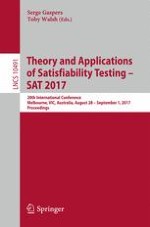2017 | Buch
Theory and Applications of Satisfiability Testing – SAT 2017
20th International Conference, Melbourne, VIC, Australia, August 28 – September 1, 2017, Proceedings
herausgegeben von: Serge Gaspers, Prof. Toby Walsh
Verlag: Springer International Publishing
Buchreihe : Lecture Notes in Computer Science
